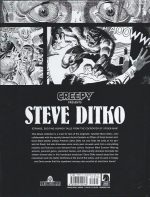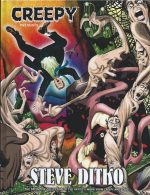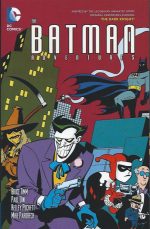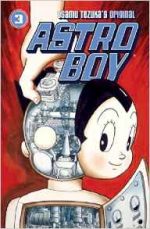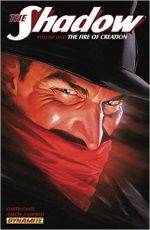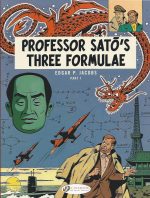
By Edgar P. Jacobs, with colours by Paul-Serge Marssignac, translated by Jerome Saincantin (Cinebook)
ISBN: 978-1-84918-292-8
Pre-eminent fantasy raconteur Edgar P. Jacobs devised one of the greatest heroic double acts in pulp fiction: pitting his distinguished scientific adventurers Professor Philip Mortimer and Captain Francis Blake against a broad variety of perils and menaces in a sequence of stellar action-thrillers which merged science fiction scope, detective mystery suspense and supernatural thrills. The magic was made perfect through his stunning illustrations, rendered in the timeless Ligne Claire style which had made intrepid boy-reporter Tintin a global sensation.
The Doughty Duo debuted in September 1946; gracing the pages of the very first issue of Le Journal de Tintin. This was an ambitious international anthology comic with editions in Belgium, France and Holland, edited by Hergé, with his eponymous, world famous star ably supplemented by a host of new heroes and features for the rapidly-changing post-war world…
Les 3 formules du professeur SatÅ was a tragically extended affair and Jacob’s last hurrah. What became the eleventh album was serialised between September 1971 and May 1972 in Tintin, after which the author abandoned his story due to failing health and other personal issues.
Edgard Félix Pierre Jacobs died on February 20th 1987 and soon after Bob de Moor was commissioned by his family and estate to complete his final tale from Jacob’s pencil roughs and script notes. The concluding album was finally released in March 1990. This led to a republishing of all the earlier exploits and eventually fresh adventures from a variety of creative teams…
Here however the action opens at Haneda Airport, Tokyo where Air Traffic Controllers experience a unique problem as a UFO disrupts their carefully plotted flight courses. With disaster imminent two Starfighter jets are scrambled to pursue the meteoric anomaly and, just before they are destroyed, the pilots radio back they are being attacked by a dragon…
As the news filters around the world, renowned cyberneticist Professor Akira SatŠargues with his assistant Dr. Kim, deeply remorseful that his latest breakthrough has been the cause of such tragedy. Kim only barely dissuades his Sensei from turning himself in to the authorities but is utterly unable to convince or prevent SatŠfrom involving visiting colleague Philip Mortimer in his crisis of conscience…
The British Professor is in Kyoto attending a succession of scientific conferences, but when an ominous outsider hears of SatŒs intentions through hidden surveillance methods, the reaction is both explosive and potentially murderous…
The first Mortimer knows of the problem is when a gang of gunmen attempt to kidnap him off the streets, but after fighting them off and escaping the old warrior returns to his hotel and finds a telegram waiting for him…
An urgent request to join old friend SatŠimmediately seems impossible to accomplish due to stringencies of train timetabling, but an accommodating journalist overhears and offers a speedy compromise…
Mortimer is suspicious of the happy accident… but not suspicious enough…
Surviving another assassination attempt by sheer force of will, the professor is then lost in the wilds of Japan but eventually manages to battle his way to SatÅ’s lab outside Tokyo where he witnesses a series of astonishing sights.
His host has worked miracles in the fields of robotics – including the dragon which so recently and horrifically malfunctioned – but is at a loss to explain how his incredible creations have gone wrong at such a late stage.
Worldly-wise Mortimer soon deduces the causes: espionage and sabotage…
As the British boffin sends for his old comrade-in-arms Captain Blake, SatÅ is comforted by the fact that the key formulae for producing his mechanical marvels have been divided and deposited at three different banks in Tokyo. The Sensei breathes even easier after arranging that only Mortimer can retrieve them but this only prompts their hidden enemy to accelerate his plans and reveal himself as one of Mortimer’s greatest foes…
Unable to induce or force Mortimer to retrieve the scientific goldmine, the mastermind has an android double constructed to visit the banks but the rush-job breaks down before the task is completed. Now the vile villain has only more card to play before the formidable Blake arrives…
This Cinebook edition then concludes with excerpts from two other Blake & Mortimer albums (The Time Trap and a tantalising glimpse of Professor SatÅ’s Three Formulae Part 2) plus a short biographical feature and publication chart of Jacobs’ and his successors’ efforts to whet the appetite for further treats in store… Cunning and convoluted, this devilishly devious tale unfolds with potent authenticity and ever-escalating tension, building to an explosive conclusion which eventually took eighteen years to conclude. At least we don’t have to wait that near life-time for the epic denouement…
Original edition © Editions Blake & Mortimer/Studio Jacobs (Dargaud-Lombard S. A.) 1977 by E.P. Jacobs. All rights reserved. English translation © 2016 Cinebook Ltd.

